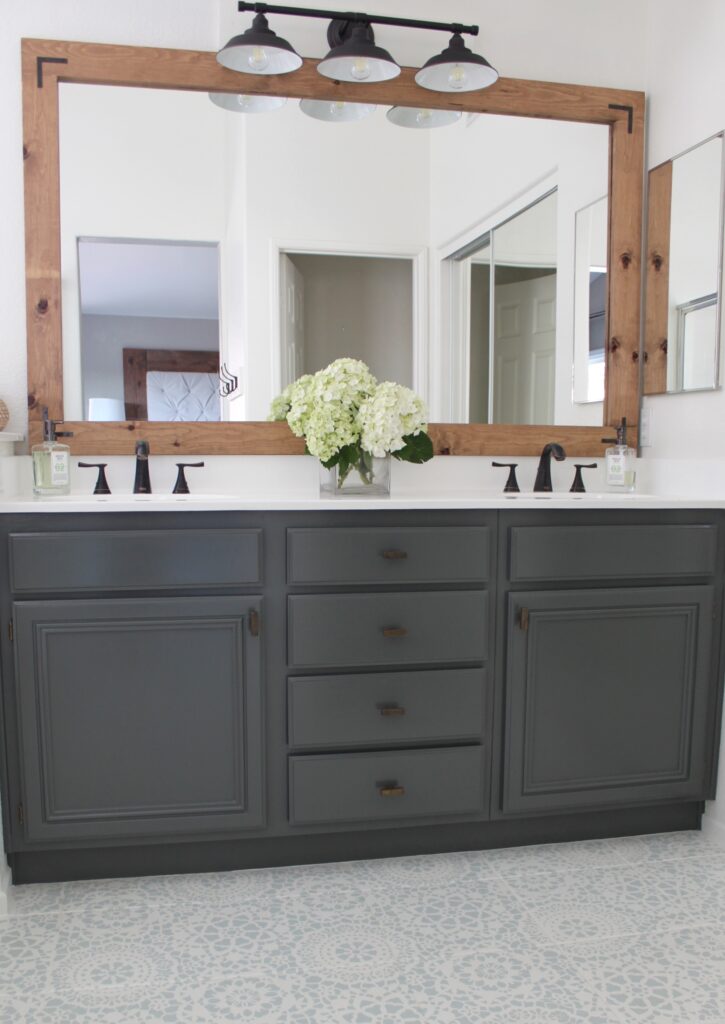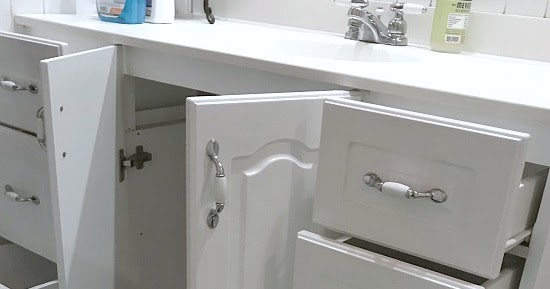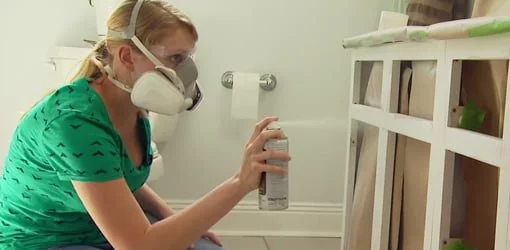Assessing the Damage: Identifying Common Bathroom Cabinet Issues
Before diving into repairs, it’s crucial to understand what exactly needs fixing. Bathroom cabinets face a variety of issues, mostly due to moisture and frequent use. Assessing the damage properly will help you determine the right course of action. Here are the most common problems you might encounter:
- Water Damage
One of the most common problems in bathroom cabinets is water damage. Constant exposure to moisture can cause wood to warp, swell, or develop mold. Look for signs of discoloration, bubbling, or a soft texture in areas where water might have leaked or accumulated. - Loose or Misaligned Hinges
Cabinet doors may not close properly due to loose hinges or misaligned doors. You might notice the door sagging or scraping against the cabinet frame. This issue is often caused by constant opening and closing or by the weight of the door pulling the hinges loose. - Peeling Paint or Finish
Bathrooms are often humid environments, and over time, this humidity can cause the paint or finish on your cabinet to peel or crack. This makes your cabinet look worn and can expose the underlying material to further damage. - Warped Wood
Wood cabinets exposed to excessive moisture or steam can warp. You might notice that the wood has bent or twisted, making it difficult to close the cabinet doors properly. Warping can happen gradually, and catching it early is key to preventing worse damage. - Scratches and Dents
Everyday use can lead to surface-level damage like scratches, dents, or chips. While these may seem purely cosmetic, over time, small damage can worsen and potentially expose the wood to moisture. - Broken or Cracked Panels
Cabinet panels, particularly on older cabinets, may crack or split due to wear or temperature changes. If you spot any cracks, it’s important to repair them before they spread and weaken the structure.

Essential Tools and Materials for Bathroom Cabinet Repair
Before starting any bathroom cabinet repair, gathering the right tools and materials is essential. Having everything on hand not only saves time but ensures the repair is done correctly. Let’s break down the key items you’ll need:
Screwdrivers (Flathead and Phillips)
Whether you’re tightening loose hinges or removing hardware, screwdrivers are a must. Both flathead and Phillips are necessary, as most cabinets use a combination of screw types. Having a set with varying sizes will make the job easier.
Wood Filler
For scratches, dents, or minor cracks, wood filler is an invaluable tool. It allows you to fill in imperfections and smooth over areas that need attention. Choose a filler that matches the type of wood you’re working with for the best result.
Sandpaper
After applying wood filler or before refinishing, sandpaper is needed to smooth out surfaces. Opt for fine-grit sandpaper to avoid scratching the wood too much while still getting a smooth finish.
Clamps
If you’re working with warped wood or reattaching broken panels, clamps are essential. They hold the pieces in place while glue or filler dries, ensuring a strong and even bond.
Paint, Stain, or Varnish
Once repairs are made, refinishing the cabinet is often the final step. Having the right paint, stain, or varnish on hand allows you to match the existing finish or refresh the entire cabinet’s look.
Drill and Drill Bits
A drill comes in handy for installing new hardware, replacing screws, or making precision adjustments. Make sure to have various drill bits so you can handle any screw size.
Fixing Loose Hinges and Misaligned Doors
Nothing is more frustrating than a cabinet door that won’t close properly or one that sags when opened. These problems are often caused by loose or misaligned hinges, but the good news is they’re relatively easy to fix. Here’s how you can tackle this issue:
Tighten the Screws
Loose hinges are often the result of screws that have loosened over time. Start by using a screwdriver to tighten all the screws in the hinge plate. If the screws won’t tighten, they may have stripped the wood.
Use a Larger Screw or Plug the Hole
If tightening the screws doesn’t solve the problem, the screw holes may be too large. You can either use a larger screw or plug the hole with a wooden dowel or toothpicks and wood glue. Let the glue dry, then reinsert the screws.
Adjust the Hinge Plate
Sometimes, the problem isn’t loose screws but a misaligned hinge. Many modern hinges have adjustment screws that allow you to move the door up, down, or sideways. Use these to align the door properly.
Add a Spacer
If the cabinet door still doesn’t close properly, you may need to add a spacer behind the hinge plate. This helps to align the door and create enough clearance for smooth operation.
Replace Worn-Out Hinges
If the hinges are old or bent, it may be time to replace them entirely. Choose a new set that matches your cabinet’s design and install them using the existing screw holes or create new ones if necessary.
Check the Door’s Weight
Occasionally, the issue may be the weight of the door itself, especially if you’ve added new hardware or if the door is particularly heavy. In that case, you may need to install additional hinges to support the door.
Repairing Water Damage and Warped Wood
Water damage and warped wood are common issues in bathrooms due to high humidity and occasional leaks. If your bathroom cabinet has suffered from water damage, acting quickly is key to preventing further deterioration. Here’s how to repair it effectively:
Dry the Affected Area
Before starting any repair, make sure the damaged area is completely dry. Use a fan or hairdryer to dry out any moisture trapped in the wood. This helps prevent further warping or mold growth.
Assess the Extent of the Damage
Once the area is dry, assess the severity of the damage. Is the wood slightly swollen, or has it started to rot? Surface-level damage can often be repaired, but rotted wood may need to be replaced entirely.
Use Wood Filler for Minor Damage
For minor water damage, such as small cracks or swollen areas, wood filler can be your best friend. Apply the filler to the damaged areas using a putty knife, making sure to smooth it out evenly. Allow it to dry completely before sanding it down to create a smooth surface.
Replace Severely Warped or Rotted Sections
If the wood is severely warped or rotted beyond repair, it’s often best to replace the affected sections. Remove the damaged panels or portions of the cabinet and cut new pieces to fit. Secure them using wood glue and screws, then sand and finish to match the surrounding areas.
Sand the Surface Smooth
After the wood filler has dried or the new section is in place, sand the surface until it’s smooth and even with the rest of the cabinet. Use fine-grit sandpaper to avoid creating scratches, and wipe the area clean with a damp cloth to remove dust.
Apply a Waterproof Finish
Once the repair is complete, it’s important to protect the cabinet from future water damage. Apply a waterproof sealant or finish to the entire cabinet, focusing on high-risk areas like the base and around the sink. This will help prevent moisture from seeping into the wood again.
Replacing Broken or Cracked Cabinet Panels
Cabinet panels can crack or break over time, especially in bathrooms where changes in temperature and humidity are frequent. If you have a broken or cracked panel, replacing it might seem daunting, but with the right approach, it can be a straightforward project. Here’s how to get it done:
Measure the Broken Panel
Before removing the broken panel, take accurate measurements. You’ll need to know the exact dimensions to cut a replacement panel that fits perfectly. Measure the height, width, and thickness of the panel.
Remove the Broken Panel
Once you’ve measured, carefully remove the broken panel. If it’s held in place with screws, use a screwdriver to take them out. If the panel is glued or nailed, use a pry bar to gently lift it out without damaging the surrounding cabinet frame.
Choose the Replacement Material
When selecting a replacement panel, make sure the material matches the rest of the cabinet. Plywood or MDF (medium-density fiberboard) are common choices, but solid wood is an option if the cabinet is high-end. The key is to match the thickness and appearance.
Cut the New Panel
Using the measurements from the broken panel, cut the new one to size. If you don’t have the tools to cut the panel at home, many hardware stores can cut it for you based on your specifications.
Install the New Panel
Once the new panel is cut, install it in place of the old one. Use wood glue, screws, or nails to secure it, depending on how the original panel was attached. Make sure it fits snugly and sits flush with the cabinet frame.
Finish and Paint to Match
After installing the new panel, sand it down to ensure it’s smooth and even with the rest of the cabinet. Then, apply paint, stain, or varnish to match the existing finish. If necessary, refinish the entire cabinet for a cohesive look.
Repainting and Refinishing for a Fresh Look
If your bathroom cabinet is looking a little worse for wear but is still structurally sound, repainting or refinishing can be a great way to give it new life without replacing it entirely. With the right prep work and materials, you can transform your cabinet’s appearance and protect it from future wear and tear. Here’s how to do it:
Clean the Cabinet Thoroughly
Before you begin painting or refinishing, it’s essential to clean the cabinet. Bathroom cabinets accumulate grime, soap scum, and dust over time. Use a gentle cleaner to remove any dirt and grease. Once it’s clean, wipe it down with a damp cloth and let it dry completely.
Sand the Surface
Sanding is a crucial step, especially if the cabinet has an existing finish or is glossy. Use fine-grit sandpaper to scuff up the surface so the new paint or finish adheres properly. After sanding, wipe away any dust with a tack cloth or damp rag.
Prime the Cabinet (If Necessary)
If you’re painting the cabinet and the original finish is dark or glossy, you’ll need to apply a primer first. Choose a high-quality primer designed for bathroom environments. This will help the paint stick better and prevent any stains or old finishes from bleeding through.
Choose the Right Paint or Stain
For painting, use a high-quality latex or oil-based paint designed for cabinets or bathroom use. These paints are more durable and moisture-resistant. If you prefer a stained wood finish, select a wood stain in your desired color, followed by a clear protective varnish.
Apply Multiple Coats
When painting or staining, it’s better to apply multiple thin coats rather than one thick coat. Thin coats dry faster and result in a smoother finish. Allow each coat to dry thoroughly before applying the next one, following the manufacturer’s instructions.
Seal for Durability
After the final coat of paint or stain is dry, apply a clear polyurethane sealant to protect the surface from moisture and daily wear. This step is especially important in bathrooms, where humidity can break down finishes over time.
Preventing Future Damage: Tips for Bathroom Cabinet Maintenance
After you’ve invested time and effort into repairing your bathroom cabinets, it’s important to maintain them to prevent future damage. Regular maintenance can prolong the life of your cabinets and keep them looking fresh for years to come. Here are some simple tips to follow:
Keep Moisture in Check
Moisture is the number one enemy of bathroom cabinets. Make sure your bathroom is well-ventilated by using an exhaust fan, especially after showers or baths. Wipe up any water spills immediately, and keep an eye out for leaks under the sink that could damage the cabinet.
Clean Regularly
Regular cleaning can prevent dirt and grime from building up, which can damage the cabinet’s finish over time. Use a mild cleaner and a soft cloth to clean the surfaces, avoiding harsh chemicals that can strip the finish.
Use Cabinet Liners
Adding liners to your cabinet shelves can protect them from spills and moisture. These liners are inexpensive and can be replaced easily if they get wet or dirty. They also make cleaning up inside the cabinet much easier.
Check for Loose Hardware
Over time, screws in cabinet hinges, handles, and knobs can loosen. Regularly check the hardware and tighten any loose screws to prevent doors from sagging or hardware from falling off.
Re-seal the Finish Periodically
Depending on the type of finish your cabinet has, you may need to reapply a protective sealant every few years. This is especially important for cabinets that are exposed to a lot of moisture. A fresh coat of sealant can protect the wood and keep it looking new.
Address Issues Early
If you notice any signs of wear or damage—such as peeling paint, loose hinges, or water spots—address them as soon as possible. Catching and fixing small problems early can prevent them from becoming bigger, more expensive repairs later on.
Water Damaged Cabinet – Repair & Prevent
How to Repair and Paint Melamine Cabinets
Who Installs Bathrooms Vanities and Sinks?
How to Repair Water Damaged Cabinet Doors in 9 Easy Steps
Related Posts:
- White Under Sink Bathroom Cabinet
- Vintage Metal Bathroom Cabinet
- Monroe Bathroom Cabinets
- Small Floor Standing Bathroom Cabinet
- Movable Bathroom Cabinets
- 4 Door Bathroom Cabinet
- Bathroom Cabinet Pull Out Shelves
- Pepper Shaker Bathroom Cabinets
- Fresca Bathroom Cabinets
- White Gloss Freestanding Bathroom Cabinets









